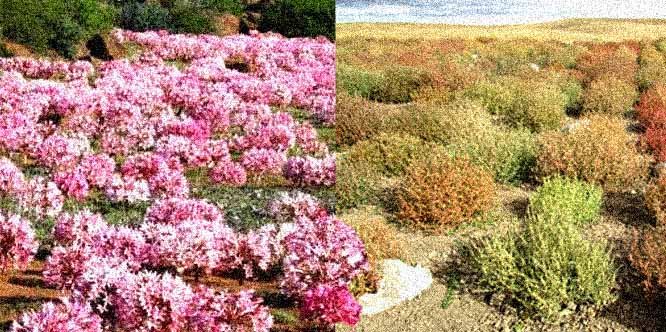Loading... Takes a minute...

A tumbleweed is the above-ground part of a certain plant that has a weak stem. In the winter, when it dies, the above-ground, dried-up portion eventually snaps off and starts rolling, blowing wherever the wind carries it. There are a bunch of different plants that fall into the tumbleweed category.
Tumbleweeds most commonly grow in steppe and dry regions where wind and big, open spaces let them roll along freely after breaking away from their roots. The whole idea behind tumbleweeds is that, as it rolls, it spreads seeds (about 250,000) or spores and creates more of the same. Some tumbleweeds roll along, hoping to find a bit of water, where its seeds can grow. Technically, there are a bunch of different ways that the tumbleweed can spread its seed, but you get the idea.
There are ten plant groups that can create tumbleweeds, but let’s focus on the first one to show up in the U.S., Russian thistle.
Oddly enough, these plants mostly come from Russia. Back in 1873, Russian immigrants arrived in South Dakota carrying flax seed contaminated with Russian thistle seeds. With no natural predators or diseases to keep them in check, these invasive plants sprouted quickly. In a matter of 3 years, Russian thistle had made its way to Chicago (thanks to tumbleweeds hitching rides on trains). Now, nearly every state in the U.S. and some provinces in Canada, has Russian thistle.
Lyster Hoxie Dewey was a government botanist from Michigan sent to investigate Russian thistle in the early 1890s. He saw that it had spread into South Dakota, North Dakota, Minnesota, Iowa, and Nebraska and wrote, "…this makes one almost continuous area of about 35,000 square miles which has become more or less covered with the Russian thistle in the comparatively brief period of twenty years." In 1897, Dewey wrote a book about Russian thistle and a couple others about industrial hemp. He was sadly disappointed to see hemp become vilified.
Some folks actually eat Russian thistle when it’s young, well before it becomes tumbleweed. But, that’s a depth into which I am not willing to plunge… you can read more about that, here!
The US Department of Agriculture has classified tumbleweeds as a highly invasive plant. In the Midwest. Nowadays, snowplows sometimes have to clear them from the road.
Garages that are left open can fill up and entrances to buildings can disappear with the throngs of tumbleweeds that pile up. While that just seems like a huge pain in the ass, it can be quite dangerous. Since tumbleweeds are all dried out, they are very flammable. Tumbleweeds can interlock, creating weed walls which are hard to break through and harder to move.
A tumbleweed is the first thing to roll across the screen in The Big Lebowski. It was filmed around a little chunk of desert called Pearblossom (just Northeast of Los Angeles). As it rolls across the screen, The Stranger tells us where we are and a little about the Dude. Then the tumbleweed rolls into places we don't usually associate with tumbleweeds: a beach, Hollywood Boulevard, etc.
The Tumblin' Tumbleweed landscape was the last shot filmed for the movie. It was filmed at Pearblossom in the Mojave desert, just north of Los Angeles. The Pearblossom footage was then optically added to a nighttime shot of the city from Simi Valley. The tumbleweed then rolls past Benitos Taco Shop (now a Chevron at the corner of West 3rd Street and South Edinburgh Avenue in LA), down Sunset Boulevard and through a couple other locations.
The tumbleweed represents The Dude. Like him, the tumbleweed is a relic of a bygone era—the wild West, in this case. The Coens put the tumbleweed in settings that were a little out of place, like the Dude at the Big Lebowski’s place, the cowboy at the bar or the nihilists just about anywhere. Also, like all of them the tumbleweed doesn't mind that it's out of place, it just keeps rolling along.

You're looking for a bunch of Lebowski shirts that you can't find anywhere else, so: click here and scroll through our Lebowski Shop on Teespring.com! Every purchase supports The Abiding Times.
Tell a Friend About The Abiding Times!
Our goal is to spread the good word of The Church of the Latter Day Dude, the fun of Achiever Fest and Lebowski Fest and the Joy of seeing The Big Lebowski (for the first or fiftieth time)!.